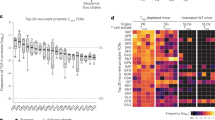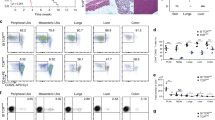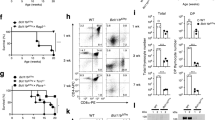Abstract
Leprosy is a spectral disease in which immune responses to Mycobacterium leprae correlate with the clinical, bacteriological and histopathological manifestations of disease1,2, so study of its pathology provides insights into immunoregulatory mechanisms in man. At the tuberculoid pole, patients have few lesions in the skin which contain rare organisms and are able to mount strong cell-mediated immune responses to M. leprae antigens. In contrast, at the lepromatous pole, patients have disseminated skin lesions containing large numbers of acid-fast bacilli and are selectively unresponsive to antigens of M. leprae. M. leprae-induced suppressor cells derived from peripheral blood have been reported to be active in vitro3–6, yet their in vivo significance has remained unclear. Because the focal point of the immune response to M. leprae is the skin lesion consisting of lymphocytes and macrophages, we have recently developed methods for isolating lymphocytes from skin biopsies of leprosy patients. We report here that two T8 clones derived from lepromatous leprosy skin biopsies, in the presence of lepromin, suppress concanavalin A (Con-A) responses both of peripheral blood mononuclear cells and of T4 clones in an HLA-D (HLA, histocompatibility locus antigen)-restricted manner. Moreover, these T8 clones suppressed responses of HLA-D-matched, but not HLA-D-mismatched antigen-responsive T4 clones to M. leprae antigens, indicating that T-cell suppression is major histocompatibility complex (MHC)-restricted at some level in man.
This is a preview of subscription content, access via your institution
Access options
Subscribe to this journal
Receive 51 print issues and online access
$199.00 per year
only $3.90 per issue
Buy this article
- Purchase on Springer Link
- Instant access to full article PDF
Prices may be subject to local taxes which are calculated during checkout
Similar content being viewed by others
References
Rea, T. H. & Levan, N. E. Archs Derm. 113, 345–352 (1977).
Bloom, B. R. & Godal, T. Rev. infect. Dis. 5, 765–779 (1983).
Mehra, V., Mason, L. H., Fields, J. P. & Bloom, B. R. J. Immun. 123, 1813–1817 (1979).
Bloom, B. R. & Mehra, V. Immun. Rev. 80, 6–28 (1984).
Salgame, P. R., Birdi, T. J., Mahadevan, P. R. & Antia, N. H. Int. J. Lepr. 48, 172–177 (1980).
Nath, I., Van Rood, J.J., Mehra, N.K. & Vaidya, M.C. Clin. exp. Immun. 42, 203–210 (1980).
Van Voorhis, W. C. et al. New Engl. J. Med. 307, 1593–1597 (1982).
Modlin, R. L., Hofman, F. M., Taylor, C.R. & Rea, T. H. J. Am. Acad. Derm. 8, 181–189 (1983).
Modlin, R. L. et al. Clin. exp. Immun. 51, 430–438 (1983).
Narayanan, R. B., Bhutani, L. K., Sharma, A. K. & Nath, I. Clin. exp. Immun. 51, 422–429 (1983).
Modlin, R. L. et al. Clin. exp. Immun. 60, 241–248 (1985).
Modlin, R. L. et al. J. Immun. (in the press).
Lamb, J. R. et al. J. Immun. 128, 233–238 (1982).
Stoner, G. L., Touw, J., Belehu, A. & Naafs, B. Lancet ii, 543–547 (1978).
Nath, I., Van Rood, J.J., Mehra, N.K. & Vaidya, M.C. Clin. exp. Immun. 42, 203–210 (1980).
Ottenhoff, R. H. M., Elferink, D. G., Klatser, P. R. & de Vries, R. R. P. Nature (in the press).
Nishimura, Y. & Sasazuki, T. Nature 302, 67–69 (1983).
Bensussan, A., Acuto, O., Hussey, R.E., Milanese, C. & Reinherz, E. L. Nature 311, 565–567 (1984).
Rees, A. D. M. et al. in Human T Cell Clones, a New Approach to Immunoregulation (eds Feldmann, M., Lamb, J. R. & Woody, J. N.) (Humana, Clifton, New Jersey, 1985).
Baxevanis, C. N., Ishii, N., Nagy, Z. A. & Klein, J. J. exp. Med. 156, 822–833 (1982).
Dorf, M. E. & Benacerraf, B. Immun. Rev. 83, 23–40 (1985).
Araneo, B. A. & Yowell, R. L. J. Immun. 135, 73–79 (1985).
Mehra, V., Brennan, P. J., Rada, E., Convit, J. & Bloom, B. R. Nature 308, 194–196 (1984).
Young, R. A. et al. Nature 316, 450–452 (1985).
Salgame, P. R., Mahadevan, P. R. & Antia, N. H. Infect. Immunity 40, 1119–1126 (1983).
Sathish, M., Bhutani, L. K., Sharma, A. K. & Nath, I. Infect. Immunity 42, 890–899 (1983).
Modlin, R. L. et al. J. Immun. 132, 3085–3090 (1984).
Mehra, V., Convit, J., Rubinstein, A. & Bloom, B. R. J. Immun. 129, 1946–1951 (1982).
Miller, R. G. Immun. Today 7, 112–114 (1986).
Ridley, D. S. & Jopling, W. H. Int. J. Lepr. 34, 255–273 (1966).
Author information
Authors and Affiliations
Rights and permissions
About this article
Cite this article
Modlin, R., Kato, H., Mehra, V. et al. Genetically restricted suppressor T-cell clones derived from lepromatous leprosy lesions. Nature 322, 459–461 (1986). https://doi.org/10.1038/322459a0
Received:
Accepted:
Issue Date:
DOI: https://doi.org/10.1038/322459a0
Comments
By submitting a comment you agree to abide by our Terms and Community Guidelines. If you find something abusive or that does not comply with our terms or guidelines please flag it as inappropriate.



